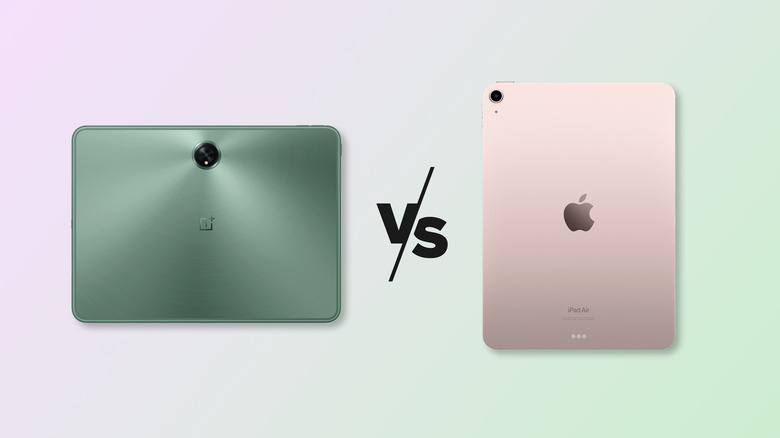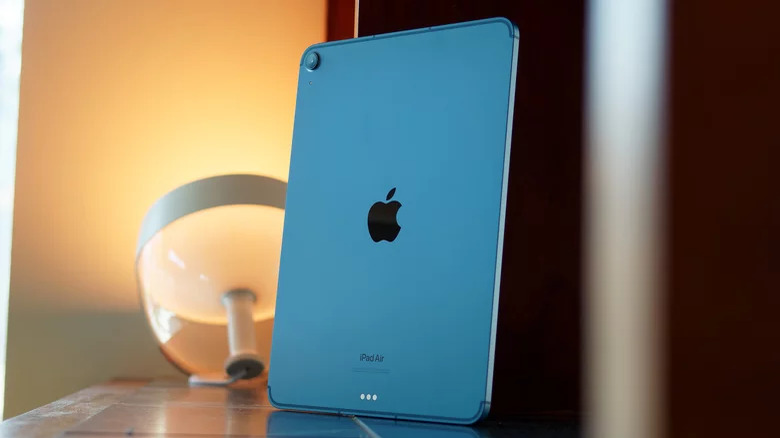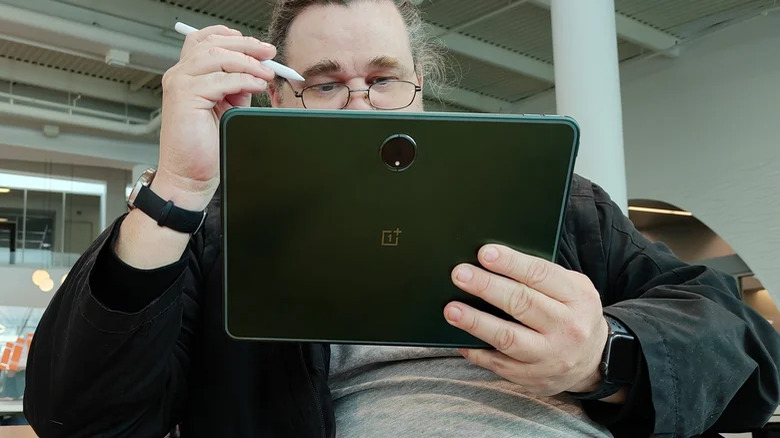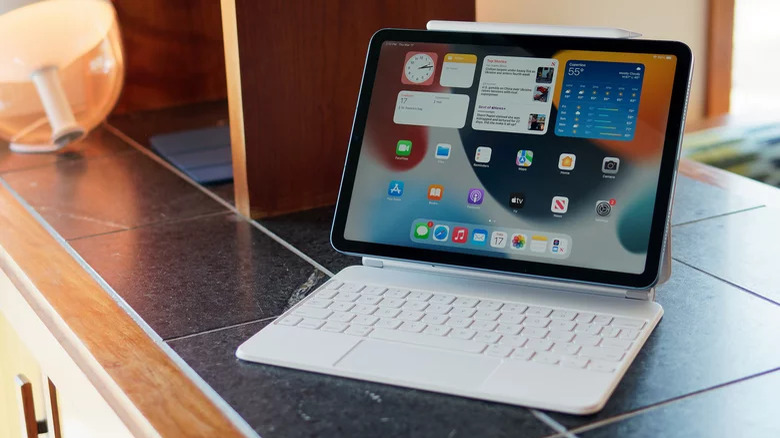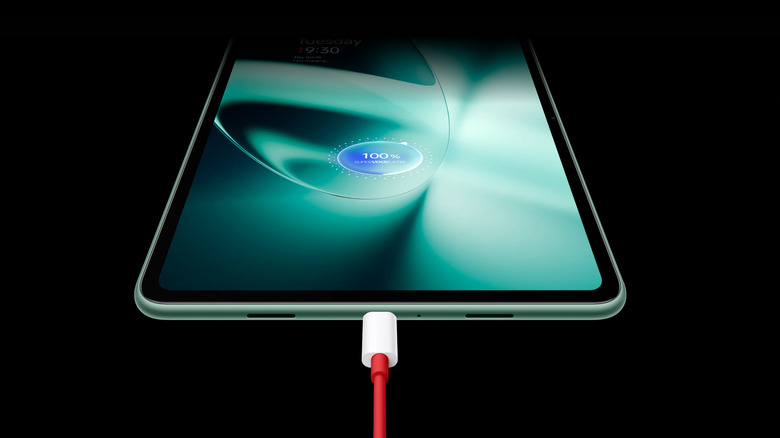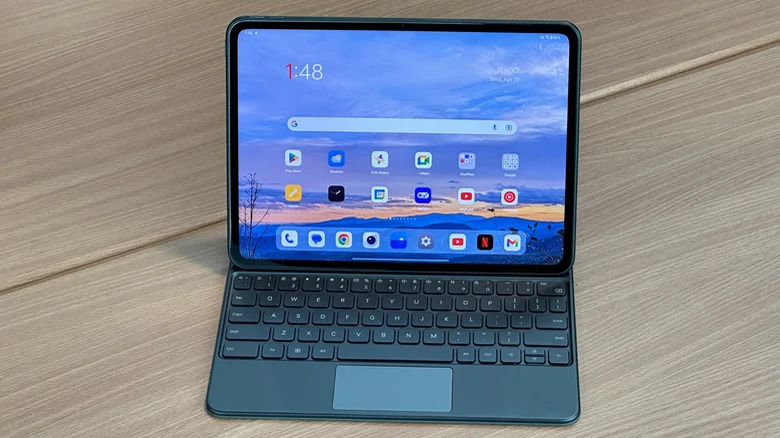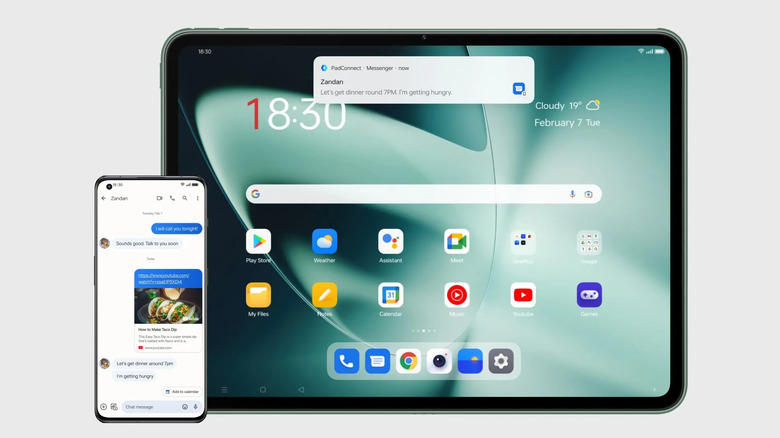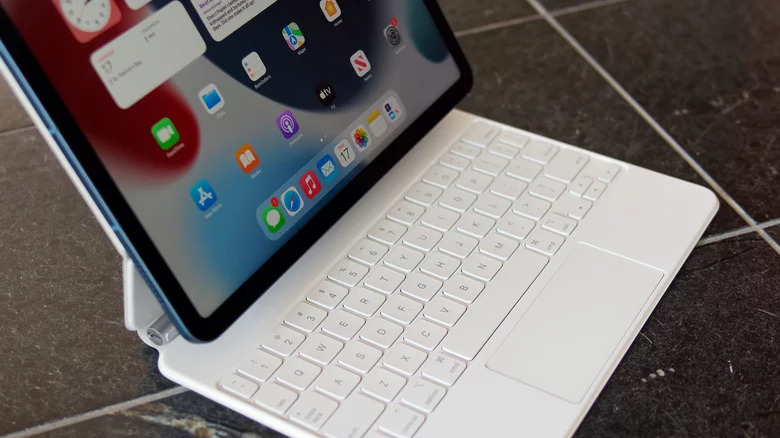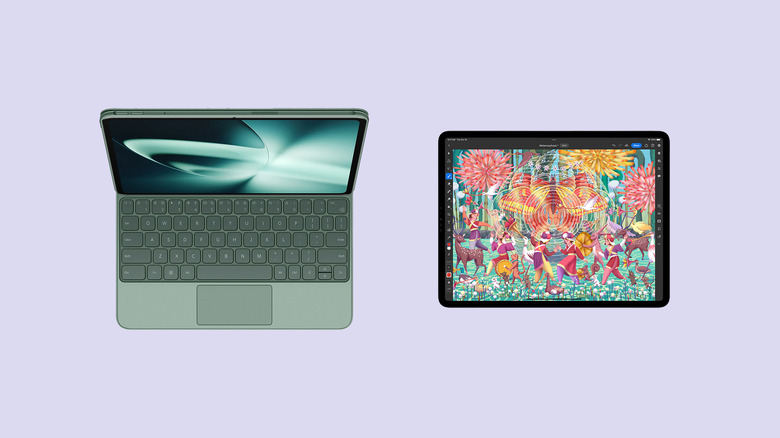OnePlus Pad Vs iPad Air: Which Is The Better Tablet For You
OnePlus has a diverse portfolio of products, ranging from smartphones across different price segments, audio equipment, smart TVs, a PC monitor, and even a mechanical keyboard. A recent addition to this portfolio is an Android tablet called the OnePlus Pad, which targets a segment largely dominated by Apple's iPad.
The OnePlus Pad appears vaguely inspired by the iPad, although the comparison also arises from the absence of premium Android tablets. Unlike smartphones, where Android enjoys a fantastic lead over iOS, the iPad is unanimously the preferred choice among seekers of premium tablets. Despite the state of Android tablets — which finally appears to improve with the rekindling of Google's interest in the market after almost a decade, the OnePlus Pad offers much to justify its sub-$500 pricing.
If you are in the market for a good tablet with a similar budget, you may also find the iPad Air (2022) a viable alternative. Although more expensive, a year old, and set for a refresh after the iPhone 15, the iPad Air packs powerful hardware that blesses it with a lifespan long enough to outlast the OnePlus Pad.
Are you deciding between the iPad Air and the OnePlus Pad? The following sections comparing various aspects of the two tablets will help make you a better decision.
OnePlus Pad vs. iPad Air: Design and Display
Neither OnePlus nor Apple strays from the traditional rectangular design, and both tablets have a display that measures roughly 11 inches diagonally, but the iPad Air has a slightly smaller footprint. While OnePlus utilizes aluminum for the chassis, Apple uses an alloy with 100% recycled aluminum that makes the iPad weigh about 100 grams less than the OnePlus Pad.
Both the iPad Air and the OnePlus Pad are less than 7mm thick, but the latter's rounded edges make it more comfortable to hold for longer. While OnePlus offers the Pad in just a single dark green color, you can choose among five vibrant options for the iPad Air. The OnePlus Pad also offers four speakers, while the iPad Air only has two, which is something to consider if you buy the tablet primarily for entertainment.
The OnePlus Pad's display stretches slightly wider owing to its unusual 7:5 aspect ratio, which is to facilitate better reading in landscape mode. Both the tablets feature fairly saturated LCD displays, but OnePlus leads with a higher resolution of 2000 x 2800 pixels and a 144Hz refresh rate. In comparison, the iPad Air's display has a lower resolution of 1640 x 2360 pixels and sticks to a 60Hz panel instead of adopting iPad Pro's 120Hz ProMotion.
Although the OnePlus Pad features thinner bezels around the displays than the iPad Air, it misses out on the iPad Air's fingerprint scanner used for Touch ID.
OnePlus Pad vs. iPad Air: Cameras
The OnePlus Pad and the iPad Air sport single cameras on both the back and the front. While OnePlus chose a 13MP camera for the Pad, the iPad Air relies on a 12MP rear-facing camera for photos and videos. Both tablets have comparable camera specifications, but we wouldn't bet on either for exceptional images. However, the iPad Air will function better if you have to capture videos. While the OnePlus Tab captures 4K videos at only 30fps (frames per second), the iPad Air is capable of 4K video recording at 60fps.
The OnePlus Pad relies on an 8MP camera for selfies, while the iPad Air uses a 12MP snapper on the front. Apple also advertises a 122-degree wide field of view with the iPad Air's selfie camera, which is especially useful for taking selfies with multiple people and during video calls.
The iPad Air also offers a feature called Center Stage, which uses AI to automatically position and adjust the frame of any video call to account for any head movements or accommodate more people. OnePlus has developed a similar feature called Limelight, so you never move out of the frame, even as you maneuver around during a call.
OnePlus Pad vs. iPad Air: Performance
Apple's custom M1 silicon powers the iPad Air. Introduced in 2020, the M1 chip's extra CPU and GPU cores add a considerable performance boost over Apple's A-series Bionic chips that drive the iPhone, the vanilla iPad, and the iPad Mini. Paired with 8GB of RAM, the custom silicon sets the iPad Air up for desktop-level performance.
Meanwhile, the OnePlus Pad also features a flagship MediaTek Dimensity 9000 chipset. The Dimensity 9000 arrived a year after the M1 and features a more efficient design but is, at best, suited for high-end smartphones. OnePlus offers up to 12GB of RAM on the OnePlus Pad globally but furnishes the U.S. variant with only 8GB of RAM.
While the iPad Air and the OnePlus Pad never disappoint during everyday tasks such as web browsing, content consumption, gaming, etc., the iPad Air will offer an extra burst of performance when needed. Apple recently extended support for professional audio and video editing tools, Logic Pro X and Final Cut Pro, to M-series iPad models. Meanwhile, multitasking is also getting as proficient as on a Mac with Stage Manager on iPadOS 17. These features make the iPad Air a capable replacement for your Mac, especially with accessories such as the Apple Magic keyboard.
In terms of storage capacities, the OnePlus Pad only has a 128GB storage variant, while iPad Air has options of 64GB and 256GB, with no 128GB in between.
OnePlus Pad vs. iPad Air: Battery and charging
The large screen and extended hours of entertainment make long battery life a crucial factor when shopping for a tablet. Both the OnePlus Pad and the iPad Air are well-furbished in this respect, with each brand claiming more than a day's battery backup. The OnePlus Pad can endure for longer with its 9,510mAh battery (about twice as large as Galaxy S23 Ultra or OnePlus 11). On the other hand, the iPad Air's battery is rated at 28.6Wh, which roughly equates to 7,700mAh. The OnePlus Pad has an evident advantage here, even though the actual battery life on both tablets depends on several factors, including the optimizations of iPadOS and Android, the intensity of tasks, and the constancy of usage.
The OnePlus Pad's advantage becomes crystal clear when considering its superfast charging speed inherited from the brand's flagship phones. It supports 67W charging through the proprietary SuperVOOC standard, with the company claiming a full battery in just one hour of charging. The OnePlus Pad also comes with a charging brick inside the box, so you don't have to buy one separately.
Meanwhile, Apple doesn't claim specific numbers about the iPad Air's charging capabilities. However, the etching at the back of the tablet suggests it supports charging at up to 20W. You don't get a charging adapter with the iPad and must either buy any USB-PD-compliant charger that supports 20W or higher charging rate or use a MacBook's charging brick.
OnePlus Pad vs. iPad Air: Software and Connectivity features
The iPad Air and the OnePlus Pad have fundamental differences in software. The iPad Air runs on Apple's proprietary iPadOS, a version of iOS especially optimized for the iPad. Meanwhile, the OnePlus Pad runs OxygenOS 13.1 based on Android 13. Despite these cardinal differences, OnePlus borrows significantly from iPadOS and brings similar elements, including a hovering apps dock at the bottom, a wide navigation bar at the bottom, visually identical system apps, and a circular mouse pointer.
Besides similarities, the OnePlus Pad gets many customization options thanks to its affiliation with Android. You can change the interface colors, icon shape and size, font style, and even use an app drawer to declutter the home screen. Although possible, such customizations are rather complex on the iPad Air.
Talking longevity, OnePlus has committed to three platform updates, i.e., till Android 16, along with four years of security updates for the OnePlus Pad. On the other hand, Apple does not need to make such promises due to its legacy of extended software support, where you can easily expect five to six years of iOS updates.
OnePlus Pad vs. iPad Air: Connectivity features
The iPad Air also benefits from the harmony within the Apple ecosystem with features such as a Universal clipboard where you can copy on one device and paste on another, Continuity and Handoff that allow you to start tasks such as writing emails or browsing webpages on one device and resume on another, and additional benefits like Sidecar which lets you use the iPad Air as a secondary monitor for your Mac. OnePlus tries to adapt some of these features by synchronizing notifications, calls, and messages from your OnePlus smartphone, but Apple's implementation remains years ahead and unbeaten.
When it comes to connectivity options, the iPad Air comes in two variants — with and without cellular connectivity through 5G. The OnePlus Pad, on the other hand, lacks any internal modem for cellular features but makes up for this deficit by automatically connecting to a Wi-Fi hotspot on your OnePlus smartphone — although this feature does not work with phones from other brands. Similar functionality can also be set on the iPad using "Instant Hotspot" if you use an iPhone.
Lastly, the USB port on the iPad Air is also DisplayPort-compliant, which means you can project its screen onto a larger monitor with a DisplayPort input.
OnePlus Pad vs. iPad Air: Accessory Support
Both Apple and OnePlus offer official accessories to improve usability. Apple's official accessories include a $179 Smart Keyboard folio case that lets you choose between two angles to rest the iPad Air but does not offer a trackpad. You must choose Apple's Magic Keyboard folio if you want better control over the viewing angles and a trackpad — along with a backlit keyboard. This gives you the form factor of a MacBook Air but also sets you back $299. You may also buy the second-generation Apple Pencil for $129, and Apple will be generous enough to add free engraving if you buy directly from the official website. However, these products will be cheaper if you buy them from a marketplace like Amazon.
Likewise, OnePlus sells a keyboard folio for $149.99 and a "Stylo" pencil for $99.99 to pair with the OnePlus Pad. You can choose one or the other for free when you purchase the Pad. However, if you bundle both together and get the Pad, folio, and pencil, OnePlus will give you 50% off the accessory you didn't choose as your free one.
In addition to official accessories, you can easily find third parties selling compatible and Apple-approved accessories for the iPad Air. The Logitech folio for iPad Air is a good example and offers a backlit keyboard and a trackpad. You are, however, unlikely to find something similar from a reputed brand for the OnePlus Pad, although unofficial accessories will be aplenty.
OnePlus Pad vs. iPad Air: Which tablet should you buy?
Both the OnePlus Pad and iPad Air offer unwavering performance for their price and are well-equipped for entertainment, web browsing, and gaming. But the final decision depends on your use case and priorities for a tablet.
The bright display and four speakers on the OnePlus Pad will suffice if you want a tablet for online content consumption — or learning, browsing on the web, using social media, or want to relish fiercely competitive games on a larger screen. It also makes more sense if you already use other OnePlus devices, as OnePlus offer continuity between them while allowing you to use the same fast charger.
The iPad Air (5th gen, 2022) is the more sensible option if you want a portable work machine. Besides the M1 chip, a mature tablet-oriented operating system and accessories, such as Apple's Magic Keyboard case, facilitate productivity with the added advantage of standalone 5G connectivity on the cellular model. The iPad is also reasonable if you're already invested in the Apple ecosystem.
Another deciding factor is pricing. The OnePlus Pad costs $479.99; you get the keyboard folio or pencil for free. The iPad Air starts at $599 for the Wi-Fi-only 64GB variant, while the 256GB variant comes at $749. You also need to pay $149 extra for cellular connectivity. With these details in mind, you should know which tablet is better for you, the OnePlus Pad or the iPad Air.
